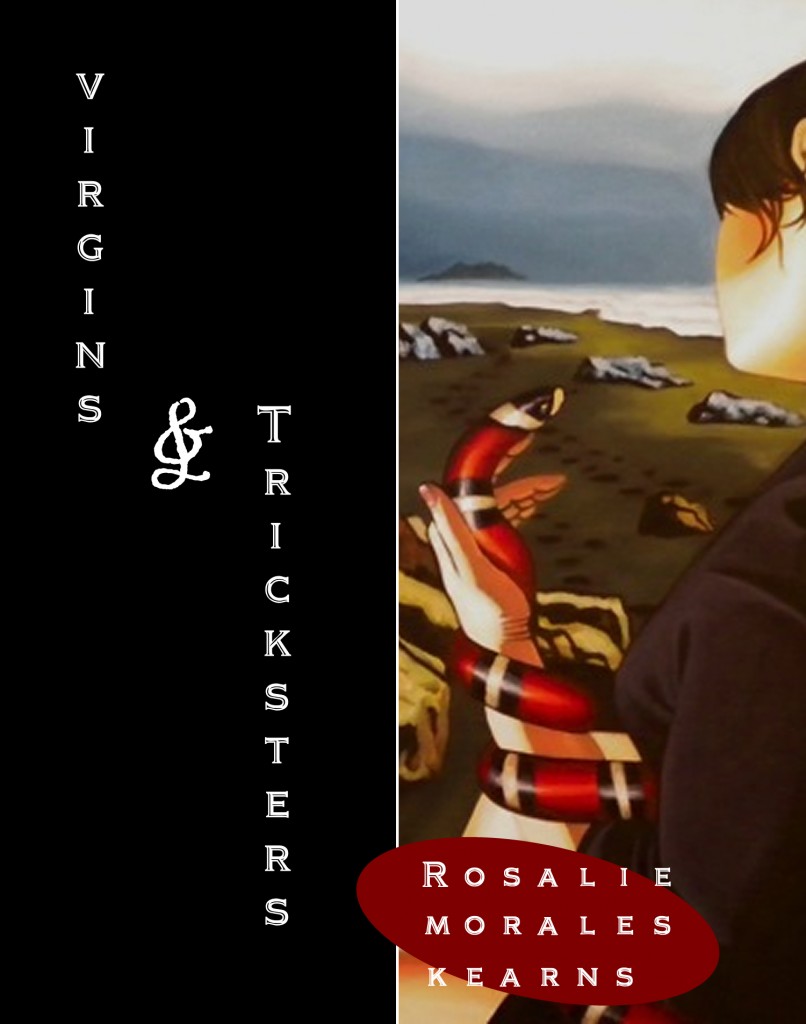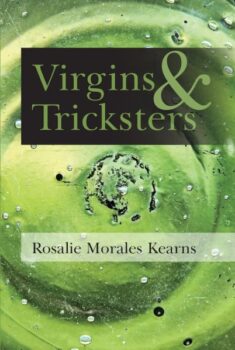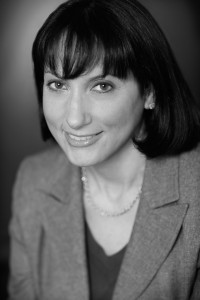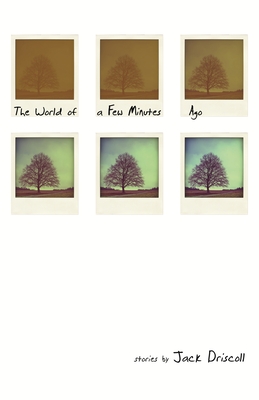Editor’s Note: For the first several months of 2022, we’ll be celebrating some of our favorite work from the last fourteen years in a series of “From the Archives” posts.
In today’s feature, Philip Graham talks with Rosalie Morales Kearns about her debut collection, Virgins and Tricksters. The interview was originally published on February 18, 2013.
Rosalie Morales Kearns’ first book of stories, Virgins and Tricksters (Aqueous Books, 2012; 2nd ed. Guayacán Press, 2017), begins with a perfect narrative hook: somewhere down the line gentle Elihu Wingate will try to throw one of his colleagues off a cliff. The reason? Read on. But before we ever get to that scuffle, a gaggle of Virgin Mary statues settle into Elihu’s home and eventually present him with a list of requests for their proper worship. Throughout Kearns’ ambitious collection she balances realism with something not quite, seriousness blended with a pervasive humor, narrative subtlety, and a long view of history and of humanity’s small place in the universe. The range of these impressive stories is perhaps best summed up in the words of God’s wife (who narrates, of course, the story “God’s Wife”):
Stories are a crucial element of the universe, no matter how you name the ingredients.
Earth, air, fire, water, and stories.
Cosmic dust, superheated gas, stories.
Matter, energy, stories.
Marge Piercy praises the “succinct, smart tales” of Kearns’ collection, and Katherine Vaz adds that Virgins and Tricksters “brims with color and kinetic power.” Rosalie Morales Kearns’ stories, poems, essays, and reviews have appeared most recently in Witness, The Nervous Breakdown, Her Kind, Numéro Cinq, and Fiction Writers Review. She has an MFA from the University of Illinois, and has taught creative writing at SUNY-Albany. She is the founder of the Lake House Collective, a group of book reviewers focusing on books by women authors, as well as the founder of the feminist publishing house Shade Mountain Press. She and her partner, the political scientist Pedro Cabán, live in Albany, New York.
Interview:
Philip Graham: Most first books, especially collections of short stories, usually arrive as slim little missives of less than 200 pages, but Virgins and Tricksters boasts an unusually generous (and elegantly symmetrical) total of 333 pages. Four of the twelve stories are close to novella-length. Were you deliberately trying to break the mold of first story collections?
Rosalie Morales Kearns: 333 is elegant, isn’t it? Given the title, though, 666 pages would have been perfect. I definitely wasn’t trying to break any molds. I looked at publishers’ guidelines, which tend to list total word count, and mine was in the normal range. Also, design choices make a difference: typeface, type size, margin size…
Initially, I read many of these stories as your advisor in the University of Illinois MFA program back in the middle aughts, and I was delighted to read them again, to revisit their many strengths and pleasures, but also to see how the vision of your thesis has expanded with the new work. Could you speak a little to the process and strategies of expanding an MFA thesis into a first book?
 My process was too haphazard to be called a strategy, so I hate to think of anyone trying to follow my example. I was working on a novel before I started the MFA program, and I listened to the conventional wisdom that MFA workshop critique is more suitable for stories than novels. I put aside the novel and started working on stories. I didn’t write them with any overarching plan in mind. They don’t have a similar style/tone/theme/ aesthetic. I did realize after the fact that my underlying vision is what unifies them. As you know, the title of the thesis was “Even the Losers,” alluding to the Tom Petty song. And of course the rest of the phrase is “…get lucky sometimes.”
My process was too haphazard to be called a strategy, so I hate to think of anyone trying to follow my example. I was working on a novel before I started the MFA program, and I listened to the conventional wisdom that MFA workshop critique is more suitable for stories than novels. I put aside the novel and started working on stories. I didn’t write them with any overarching plan in mind. They don’t have a similar style/tone/theme/ aesthetic. I did realize after the fact that my underlying vision is what unifies them. As you know, the title of the thesis was “Even the Losers,” alluding to the Tom Petty song. And of course the rest of the phrase is “…get lucky sometimes.”
Your collection is unusual because some stories indeed boast happy endings. But what’s most impressive is that they are so earned, and so surprising in how that happiness accomplishes itself. In “Devil Take the Hindmost,” poor Pilar goes through a series of setbacks in her professional life, leading to her dying in a bio-chemical disaster, and then even arrives in Hell! But Hell turns out to be a lovely and unpredictable place, a shelter for the losers of the world, and the way you juggle the weavings of time and memory and shifting identity in this afterlife is stunning—it’s an eternity of internally orchestrated transformations that I can imagine getting used to.
I wanted to give Pilar a beautiful afterlife. That location, Bald Eagle State Forest in central Pennsylvania, is where I would want to end up, if given the choice. I hope I’m consulted.
Then you have to wonder, is it an “afterlife” if it’s bleeding into her “former” life?
I keep struggling with the notion of nonlinear time as I imperfectly understand it, from books on string theory and multiverses. I can’t think about that possibility in a logical, linear way. I can only weave it into a story, think of it through story.
I wouldn’t call it Hell, though, despite Dev’s presence. Dev and “the other guy” are on the same team. What’s entertaining to me is that Dev’s explanations never really get through to Pilar. She’s uninterested in religion, spirituality, whatever you want to call it. She has never been a believer, and her ecstatic afterlife doesn’t change that.
I mentioned earlier the generosity of the page count of Virgins and Tricksters, but there’s another generosity that marks the book—your deep empathy for your characters. You seem to be a big fan of third person omniscient, dipping back and forth into your characters’ minds, yet it never seems arbitrary. I think this is because your intent is not to expose your characters, but to reveal them, in all their contradictions and frailties.
I love my characters extravagantly. That’s one of the reasons I have such fun with an omniscient narrative voice—it can be a shameless partisan for the characters, even as it’s recounting for the readers some of the characters’ less appealing qualities, and that, I think, adds to the humor. For instance, in “The Associated Virgins,” there’s a supporting character with a mercenary streak, in contrast to the gentle, idealistic main character, but the narrator flat-out tells the reader not to judge him too harshly: “Sure, he’s got an eye on the bottom line, like any good businessman. We can’t all be sensitive and thoughtful in this world. Where would we be then?” Of course, when you think of it, we’d be in pretty good shape if all of us were indeed sensitive and thoughtful.
A dear friend in college used to tell me about his Irish grandmother and how she always made excuses for him no matter how he misbehaved. One day he banged the family car into a fire hydrant and his parents were furious, but there’s Granny with her heavy Irish accent saying indignantly, “Well Jesus, Mary, and Joseph! Who put the damn thing there for the poor boy to hit?” Granny is my narrative role model.
Ha, that’s so funny! But I respectfully submit that you’re infinitely subtler than that Granny. My main take-away is your deep curiosity about what makes each character tick. One of my favorite moments of this empathetic dipping is when six-year-old Frannie notices during a church service that “the grown-ups are glassy-eyed like the row of stuffed animals lined up in a shelf in her bedroom. Boredom is changing them into plush toys, it’s spreading through the congregation, coming her way. She feels herself turning into her rag doll, Marigold. Her hair slowly turns to dark blue yarn. Her eyes aren’t made of eyeball anymore, but shiny black embroidery thread sewn in diamond shapes. Freckly tan skin becomes smooth beige cotton. She feels her mouth form a tiny, red-stitched smile.” This is such a beautifully succinct evocation of childhood, filled with tenderness and humor.
 Thanks! “Days Are as Grass” is the only time I’ve ever delved into the point of view of such a small child. This particular character came to me so clearly; otherwise I don’t think I would have attempted it. I well remember how bored I was in church at that age.
Thanks! “Days Are as Grass” is the only time I’ve ever delved into the point of view of such a small child. This particular character came to me so clearly; otherwise I don’t think I would have attempted it. I well remember how bored I was in church at that age.
Yet you’re good at depicting priests, I notice. I especially like Father Kevin’s internal struggle, in “Days Are As Grass,” to not be attracted to Miriam, Frannie’s mother. A lesser author might settle for a smirky judgment, but you present his thoughts with great sympathy, as a man trying to adhere to a path, in spite of himself.
Father Kevin is a lovable guy. Not only does he have a crush on Miriam, but he’s in awe of her: “when he daydreams about Our Lady appearing to him in a vision, […] she looks like Miriam Ramos.” He wouldn’t put it past her to be able to walk through walls. He tries not to think about her as he’s going to sleep, but she enters his dream anyway, in triple-goddess form as the three Marys at the foot of the Cross (Miriam is Hebrew for Mary).
In the collection as a whole, I count at least three priests, or four, if we include the bishop in the painting—
—there’s also a bishop in “The Priest’s Wife—
—how could I have forgotten him? Plus a Protestant clergyman, and the medieval monk Brother Wulfstan. And the odious hermit Brother Raedwald who caused so much trouble. And where there’s no priest, we’ve got the Virgin Mary. The Judeo-Christian God shows up as a character in several stories, and other deities too. And of course Dev.
Lots of different deities: Lamanja, Elegua, Muyingwa, Gyhldeptis, Osiris, Changó, and the Taíno ancestors of Puerto Rico (do they count as gods?), among many others. And they all possess the same charming combination of wisdom and foolishness as your human characters.
And the novel I’ve just finished focuses on a female Roman Catholic priest. Needless to say, it takes place in a slightly alternate version of the present.
Like bad pennies, those priests, showing up everywhere.
Bad pennies indeed, and yet you always manage to squeeze some extra currency out of them. I love the moment in “The Priest’s Wife” when the wife watches the bishop’s procession making its way across a field. This bishop is in the process of ending the practice (common in the middle ages) of rural priests being married, having a family, and specifically he has targeted her own marriage. And here’s what she thinks as he passes by:
This is what I’ve learned from our new bishop. We need love like air. How small he looks from this distance. So harmless.
Instead of condemning him in her mind, she finds a reason to be grateful—by causing a split between her and her husband, she now sees in starker detail, through its absence, the importance of love. This inadvertent gift makes him seems small in her eyes, harmless, but of course he still wields power over her life. You do this so often in your work—taking a moment and turning it this way, then that, adding to its complexity.
With that story in particular, I think, it was easier to achieve some subtlety, some complexity, for two reasons: the narrator’s personality and the point of view I used. One of the ironies of the story is that the priest’s wife is not only more intelligent and sensible than her husband, she’s wiser than he is, more spiritual, more profound, but being a woman, she had no chance of having the leadership position that had been thrust upon him. The point of view also lends itself to a contemplative mood: this is a first-person narrator who is often addressing the Virgin Mary. Having a character address another character changes a first-person story in interesting ways. And I think you show your best self if you’re talking to a divine being, giving her a running commentary on your own life.
I also admire how you are pretty tough on the history of colonialism in many of your stories. First, that this history is even a presence in your work—there’s often a long look in your stories, a stretch of cosmology or history lurking somewhere, sometimes up front, sometimes in the background. But it’s never presented in a knee-jerk fashion. In “The Pirate’s Wife,” for instance, you show sympathy for the indentured laborers—those ground troops of the colonial endeavor—most of whom are, of course, poor:
Somehow from this land of poor people, ships are filled with gold and silver and jewels, hides and fur, timber and tobacco, and it all goes into His Majesty’s treasury and the people are left here, tilling, mining, fetch-and-carrying, patting their pockets for a spare coin. Even when they find one, it’s never made of gold.
My mother was born and raised in Puerto Rico. You can’t read Caribbean history and Caribbean literature without being aware of that huge backdrop of colonialism looming over everything, whose most hideous product was plantation slavery. A trauma that hasn’t been resolved. That legacy of slavery and racial oppression is what makes the protagonist of “The Revolutionary’s Wife” reject her own privilege as a white-skinned daughter of a wealthy family. In “Taínos at Large,” the protagonist’s slave ancestors are always on her mind. A connection with the ancestors is vital to her Afro-Puerto Rican spiritual tradition, and also she’s angry that both their sufferings and their contributions are minimized, forgotten. Those ancestral spirits are the group narrator of the story.
And then there are the former indentured servants in “The Pirate’s Wife.” From a lifetime of poverty, Sarah has a ground-level view that is really a very panoramic perspective, a realization that almost everyone she knows works themselves to death and winds up with nothing, while the king enriches himself. Then at the end of the story she climbs up to talk to God on his throne and she gets this breathtaking, bird’s-eye or god’s-eye view of her whole world. Sarah assumes that God is indifferent to the sufferings of human beings, because he’s so far away, and his world is so beautiful and clean. I leave it to the reader to decide.
Which reminds me of the Revolutionary’s wife, who looks back on her life and long exile from her country and says, “It’s not a question of right or wrong, deserving or undeserving. It’s not cruel. Why waste your breath calling the universe cruel? You have to laugh.”
What she calls the “truth of Elegua,” the African-diaspora trickster figure. I love the ironies: here’s someone from an educated, privileged background, who considers herself an agnostic, skeptical of all received truths and especially skeptical about religion. And from a tradition that’s been vilified as primitive superstition, she finds a complex, profound theological concept, a worldview, that helps her make sense of her life, helps her endure.
I love the trickster. The trickster answers so many questions.
Links and Resources:
- Check out Rosalie’s essay for Necessary Fiction‘s series “Research Notes,” which reflects on some of the research she did for her collection.
- Read her story “Triptych” at Numéro Cinq.
- Here’s Ellen Prentiss Campbell’s review of The Female Complaint, subtitled “Tales of Unruly Women,” edited by Rosalie and published by Shade Mountain Press.
- Visit Shade Mountain Press to learn more about the feminist press and their other books.
- Finally, please visit Rosalie’s website for more information on the author and her work.







